Past few months have been tough for digital publishers. Starting with the January slump, cookie demise, and now with Coronavirus outbreak, 2020 isn’t failing to present challenges.
Nations across the world are under lockdown. As we all are trying to minimize the pandemic’s impact on our health, we also want to reduce the repercussion on our businesses as well.
Due to lockdown, many publishers are seeing an all time high traffic as users are actively surfing the internet. However, strangely the ad revenue is not elevating. Reason being brands pulling out money from the market in efforts to minimize their business spends. Similarly, local advertisers have stopped all their advertising campaigns because they don’t see a point of running a campaign when they are incapable of converting users.
Advertisers who are still investing in digital advertising are opting for ‘corona’ free content. Because ‘Coronavirus’ has been blacklisted as a keyword. For news publishers, this is alarming as most high traffic content is about COVID-19 and they can’t monetize it because of keyword blacklisting.
Because of all this, 88% publishers wouldn’t meet their annual business goals, says Digiday.
Here is what we found by surveying digital publishers and ad tech experts:
- Traffic: 59% of publishers reported an increase in monthly traffic
- Revenue: 90% reported a revenue drop
- Fill rate: 85% are noticing a decrease in fill rate
Traffic and fill rate are the two pillars of ad revenue. On one side, the traffic is going up, the fill rate is decreasing exponentially.
Are all the hopes lost then?
Certainly not. There are some downfalls and can be handled by tweaking the current strategies a little. Here are some that you could try:
Changes in Strategies to Consider
Choose the Right Category
eCommerce (especially apparel and fashion) companies are cutting their advertising budgets. But we have streaming services (like Netflix) and games development companies putting more into advertising.
Since, there is a significant change in user’s behaviour because of the stay-at-home mandate, there is a major economic shift noticed across the globe. Yelp’s report shows an increase in traffic in fitness, sport, and pet breeder categories. While tourism, breweries, and shopping centers continue to go down.

On the same note, Pubmatic released its data by analyzing 15 trillion advertisers’ bids that showed increased ad spend in the news, hobbies, computer, and technology categories.

For publishers, it is high time to make changes in the ad category or niche(s) they allow on their websites. For more personalized results, review your own Google Ad Manager data to check fluctuation on category-wise bids. If you found a significant increase in a particular category (say games), time to assign more inventory to this category.
Make Use of Video Advertising
Video streaming services, like Netflix, are cutting on video quality to reduce pressure on ISPs. Basically, people locked down in their homes are spending more time on Netflix, consuming server power and not allowing bandwidth for other tasks.
Clearly, consumers are more invested in video now than ever before. For publishers, this is a lucrative time to start with video advertising. Publishers with editorial content can take help of outstream video advertising.
Yes, the video ad spend is not as high as it was before the pandemic. The report shows that video fill rates have also declined in the last few weeks. Watching That Ltd., a U.K.-based video analytics firm, measured 14 – 30% decline in video ads fill rate in March compared with February.
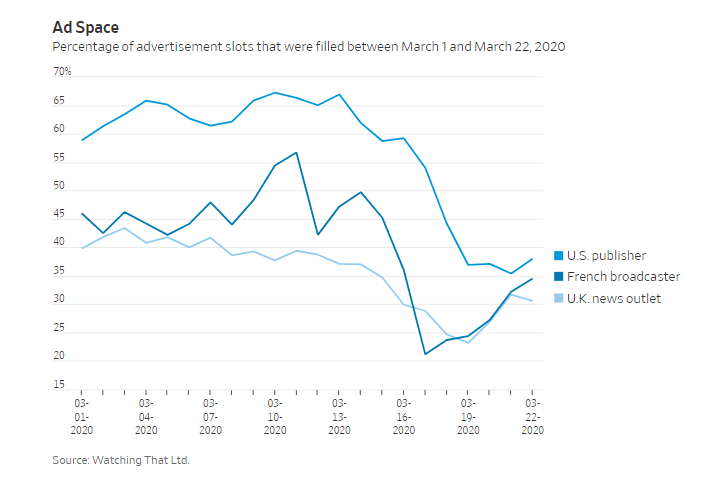
However, on a positive note, video ads with ‘water splashing/cleaning’ have increased six times than before 12th March, found Pattern89. Similarly, they have seen a 27% decrease in video ads with hugging, holding hands, shaking hands, or touching to promote social distancing.
In case of video ads, it also boils down to the category you choose.
Start by finding a good video ad network and ask them to focus on categories with spike in advertiser’s interest.
Focus More on Direct Deals
Revenue from programmatic auctions are becoming uncertain because of the Coronavirus pandemic. In such a case, direct deals should offer some stability in earnings.
With direct deals, publishers reserve a part of their inventory for a specific advertiser. And the campaign runs either for a specific number of impressions or until the budget lasts. This ensures publishers some earnings even with irregularities caused by the pandemic.
Publishers can also dodge the problem of keyword blacklisting by negotiating it with the advertisers directly.
To get started, you need to work on your pitch and update the current price. Because of the lockdown, many brands are considering virtual events. Your website can be a medium they would want to use for promotional purposes. See if you could update your media kit to attract such advertisers.
Improve Demand Base
You still need to work on the inventory left after direct deals. Generally, publishers auction the remaining part of the inventory via header bidding or Google Ad Exchange.
Generally speaking, it is recommended to go after the quality of demand rather than quantity of demand. But with the recent crisis in the picture, it is time to consider quantity as well.
As mentioned, active advertisers are decreasing, chances are your current demand partner is unable to fulfill your inventory requirements. Partnering up with new ones should open up more opportunities.
If you can’t get access to new quality demand on your own, then consider reaching out to demand management companies (like AdPushup) that can help you increase and manage your demand partners.
Get Whitelisted
As mentioned above, ‘Coronavirus’ is considered a risky keyword now and is being blocked by advertisers.
Publishers are trying their best to whitelist it. In UK, publishers signed an open letter from Newsworks, the marketing body for national newspapers in the UK, which asks advertisers to check that they’re “not unknowingly blocking trusted news brands” for “online stories with the word ‘coronavirus.’”
You can also participate in such initiatives or directly request your advertisers to whitelist your inventory.
Update Your Floor Price and Improve Fill Rate
Your floor price can be the reason for a sharp decline in eCPM. Advertisers are reducing their ad spends by reducing their CPM rates. If you, as a publisher, don’t match your numbers according to the demand, then you might end with a low fill rate and even lower eCPM.
During the summer and January slump, we recommended our publishers to reduce their floor price. Consider the same in this case.
Especially in case of header bidding, rethink floor price and timeout period to improve fill rate and avoid your impressions from getting wasted.
It is also important to keep up with the required security. With low floor prices, there is a chance that bad actors will try to push malvertising practices via your websites. Try reaching out to ad fraud prevention companies to maintain dignity of your property.
Invest in Layout Optimization and Ad Refresh
Ad layout optimization is testing different layouts and using historical data to pinpoint a set of ad placements that works best for web pages. Knowing your best performing ad placements and focusing on them is highly recommended for publishers seeing decline in ad revenue due to COVID-19.
Ad refresh reloads the ads on the user’s screen based on user activity or time spent on the webpage. Publishers with an engaging audience (who spend a lot of time on their webpage) can benefit from ad refresh. If you are not onboarded with it, then it’s high time to use this technology and increase your revenue per session.
Auto-refreshing can be a money-printing machine, allowing publishers to print an infinite amount of inventory
Ian Trider, director at Centro
CCNA7, an education niche publisher, achieved a 534% increase in overall ad revenue using ActiveView Refresh along with header bidding and adblock monetization techniques.
But there are concerns related to the ad viewability and increased page load time. Well, it is never recommended to risk viewability and page latency. We conducted a webinar to understand do’s and don’ts of ad refresh and monetize without risking user performance.
Don’t Compromise Ad Viewability
Advertisers are not going to spend their dollars on ads that are not viewed by users. Especially during the pandemic when they are already pulling money out, viewability becomes even more important.
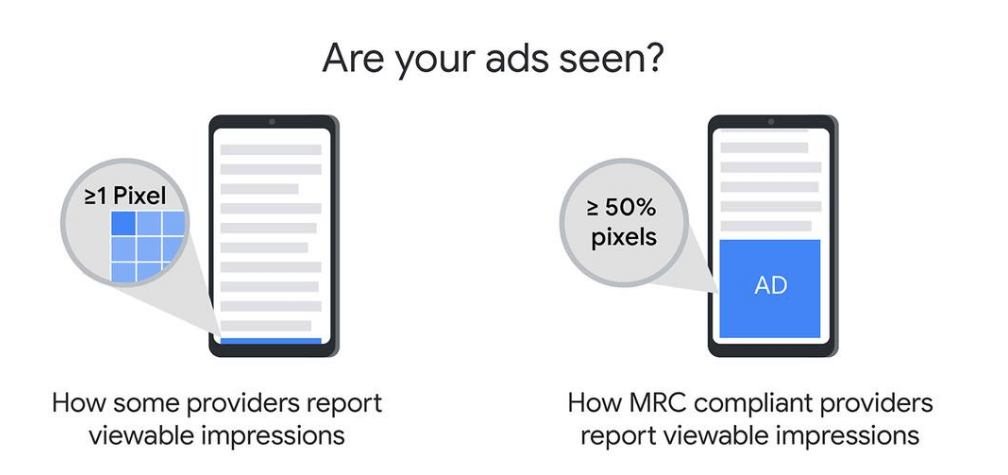
We all know ad tech is quite serious about ad viewability. Yet, average publishers are known to have only 50.2% viewable inventory. The rest of 49.8% is unseen by users. Similarly, chances are a significant part of your inventory has the same problem. It is recommended to audit all the placements for minimum ad viewability requirements. Here are some specific ad viewability criteria pointed out by IAB:
- 50% pixels of video ads should be in active view for more than 2 seconds
- Display ads should have 50% pixels active on user’s screen for 1 second
- And for large banner ads, 30% pixels should be in active view for 1 second
Anything less than these, advertisers would avoid dealing with your inventory. Design your placements to hold these numbers. Again, layout optimization is the possible solution here.
How’s Google Helping?
UK publishers recently criticized Google for blocking and filtering ads on Coronavirus news pieces. It was also stated that ad blocking can cost small and medium news publishers an estimated £50M.
In response, Google launched News Initiative to help the news industry. Along with a journalism training course, it has also added fact checking and verification tools to help produce original and informed journalism. Here are other initiative that should help news publishers:
Waive ad serving fees: Google is waiving ad serving fees for news publishers for five months. There are certain requirements that need to be fulfilled in order to claim this exemption.
If you are a news publisher, then keep an eye on your account statement or contact your Google representative for more information.
Launched a relief fund: For small and medium-sized news organizations, Google has launched a global Journalism Emergency Relief Fund. This is to provide financial support during the crisis and keeping up with quality journalism. Publishers can apply by filling a quick application form till April 29, 2020.
In Closing
If you are already onboarded with some of these techniques, we recommend to take this COVID-19 assessment and check whether your ad stack is ready for fluctuations.
We excluded any tips on related to subscription models. This is because many publishers (The New York Times, The Wall Street Journal and Bloomberg News) have taken down their paywalls to offer free information in these days of crisis. In such a time, experimenting with paywalls can backfire and badly affect your online reputation.
Consumers are likely to understand the relationship between free content and ads for monetization. IAS studies shows 78% users are fine with seeing ads on COVID-19 posts.
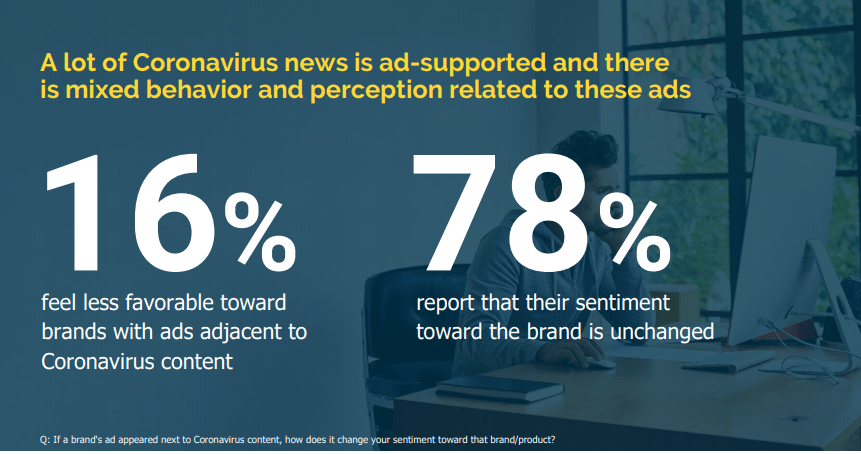
We hope these best practices will help you get by this hard time. Please share your experience. And feel free to reach out if you are noticing a major downfall in your revenue. We would be really glad to help in any way possible.
Updated on: April 23, 2020

Shubham is a digital marketer with rich experience working in the advertisement technology industry. He has vast experience in the programmatic industry, driving business strategy and scaling functions including but not limited to growth and marketing, Operations, process optimization, and Sales.



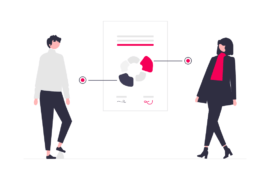
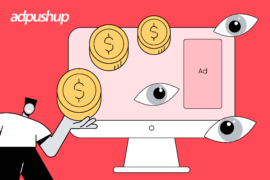



2 Comments
nice!
Quite Insightful!